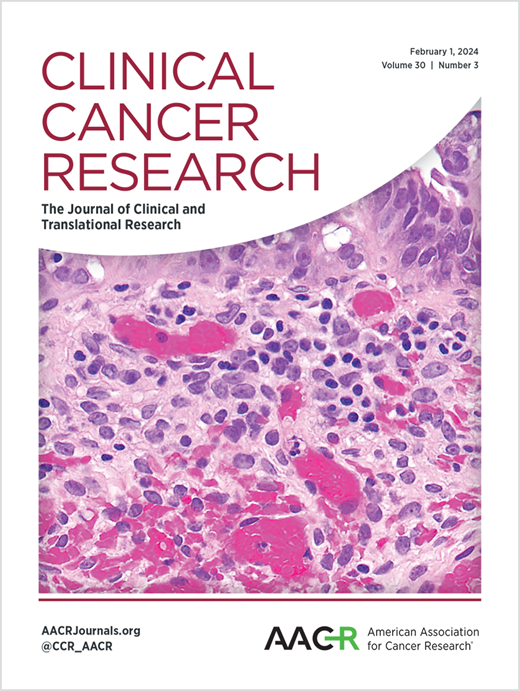地西他滨对tp53突变MDS/AML的初始有利反应机制及随后复发的潜在机制
IF 10.2
1区 医学
Q1 ONCOLOGY
引用次数: 0
摘要
目的:骨髓增生异常综合征和具有复杂和单体核型的急性髓系白血病患者TP53突变(TP53m)发生率高,对诱导化疗反应差,预后不良。这些疾病可能对地西他滨有反应,但其机制目前尚不清楚。实验设计:在一项II期临床研究中,骨髓增生异常综合征和急性髓系白血病患者使用地西他滨治疗10天。在这项研究中,我们收集了一系列患者在地西他滨治疗前和完成时,形态缓解和复发的样本。通过靶向髓细胞面板测序、纳米孔DNA胞嘧啶甲基化测序和单细胞转录组学对样本进行查询,以研究白血病和免疫人群之间潜在的相互作用。结果:综合分析允许在个别患者白血病和免疫细胞群内转移动力学的表征。单细胞转录组学分析证实了地西他滨治疗后TP53m应答者的免疫激活。复发时,白血病人群表现出MYC信号和热休克反应的上调,而T细胞表现出衰竭的特征。结论:我们的工作强调了5300万接受地西他滨治疗的tp5300万患者中白血病和免疫群体之间复杂的相互作用,这可能解释了临床反应和随后的复发。本文章由计算机程序翻译,如有差异,请以英文原文为准。
Mechanism of Initial Favorable Response to Decitabine in TP53-Mutated MDS/AML and Potential Mechanisms of Subsequent Relapse
Purpose: Myelodysplastic syndrome and acute myeloid leukemia with complex and monosomy karyotypes show a high prevalence of TP53 mutations (TP53m), poor response to induction chemotherapy, and adverse outcomes. These diseases may respond to decitabine, but the mechanisms are presently unclear. Experimental Design: Patients with myelodysplastic syndrome and acute myeloid leukemia were treated with decitabine for 10 days in a phase II clinical study. In this study, we collected serial samples from patients before and at the completion of decitabine treatment, morphologic remission, and relapse. The samples were interrogated with targeted myeloid panel sequencing, nanopore DNA cytosine methylation sequencing, and single-cell transcriptomics to investigate potential interactions between leukemic and immune populations. Results: The integrative analysis allowed for the characterization of shifting dynamics within leukemic and immune cell populations in individual patients. Single-cell transcriptomic analyses confirmed immune activation in TP53m responders after decitabine treatment. At relapse, leukemic populations showed upregulation of MYC signaling and heat shock response, whereas T cells showed an exhaustion signature. Conclusions: Our work highlighted the complex interplay between leukemic and immune populations in TP53m patients upon decitabine treatment that might account for clinical responses and subsequent relapses.
求助全文
通过发布文献求助,成功后即可免费获取论文全文。
去求助
来源期刊

Clinical Cancer Research
医学-肿瘤学
CiteScore
20.10
自引率
1.70%
发文量
1207
审稿时长
2.1 months
期刊介绍:
Clinical Cancer Research is a journal focusing on groundbreaking research in cancer, specifically in the areas where the laboratory and the clinic intersect. Our primary interest lies in clinical trials that investigate novel treatments, accompanied by research on pharmacology, molecular alterations, and biomarkers that can predict response or resistance to these treatments. Furthermore, we prioritize laboratory and animal studies that explore new drugs and targeted agents with the potential to advance to clinical trials. We also encourage research on targetable mechanisms of cancer development, progression, and metastasis.
 求助内容:
求助内容: 应助结果提醒方式:
应助结果提醒方式:


